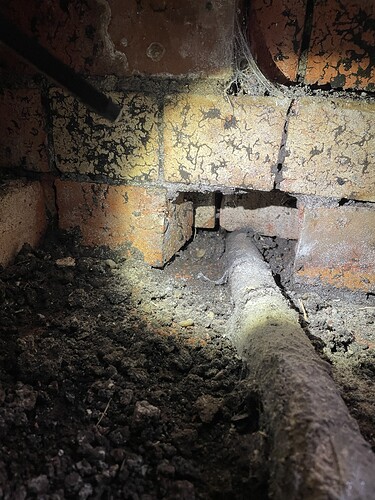We’ve discovered an old gas pipe (1910 iron wrapped in bitumen) entering a floor void three bricks below damp proof course inside & below soil level outside. Water comes in around it when it rains! The gas people (cadent) don’t know whether it is live or dead so we can’t remove it.
Does anyone have any suggestions as to how to seal around it permanently?
Thanks D&H
Do you know whether the gas grid in the street has been upgraded to plastic? If so look for a plastic feed to your meter.
My local gas company upgraded to plastic and rather than attach to old iron spurs, causing weaknesses, they lay new plastic to the meters, moving meters where necessary. The cast iron ones were then abandoned, there not being enough scrap value to justify their removal.
As an aside, the company moved my gas meter to outside. This means that having now had the meter removed there is no gas into the house, which makes me feel safer than if there was a pipe that could supply a house fire.
Regarding water ingress. The place to stop water getting in is the outside of the wall, not the inside. Otherwise you will end up with a saturated wall and rotting wood.
Could you excavate a trench around the outside of the house, apply damp proofing and then fill the trench with a free draining mix of stones. I.e. build a French drain.
Thanks Tim, we’re in process of digging out all around the perimeter of the house & intend to infill with foam glass aggregate which doesn’t hold onto moisture. When you say ‘damp proofing’ do you have any particular products in mind?
Re gas line:
The street has not been updated to plastic.
We have a meter outside which was fitted 15 years ago, it visibly has a plastic feed above ground. Cadent don’t know if this feed is plastic from the street or connected to the old pipe under the house somewhere. They say they can only tell if they dig up the driveway, the garden, the street & solid floors in the house to find both ends of the pipe!
They also can’t rule out that the old pipe doesn’t also feed the house next door!!
So living with the pipe & sealing around it seems the least worst option.
Regarding damp proofing, what is the state of the outer surfaces of the walls below ground level and up to the damp course?
Regarding the pipe, if you are planning to convert to insulated solid floor at any time you need to put more effort into investigating that pipe, with the aim to remove it if at all possible. Gas pipes have not been allowed below concrete for about 20 years now. If you intend to retain a vented void then just accept that you are lumbered with it.
The external brickwork below dpc is in good condition. Three courses of blue engineering on red brick footings. Original lime mortar pointing below ground is probably a bit rough.
Internally the dpc is working perfectly & joists are sound. There is reasonable cross ventilation into the void via air bricks.
We’re resigned to not filling in the void. Obviously we need to sort out the water ingress before we decide how to proceed with any floor insulation.
You are lucky. In my opinion vintage blue engineering brick is the ultimate in bricks!
To tackle ingress you can either assume that the lime mortar may allow liquids through (very slowly) and treat the whole wall below ground level or concentrate on the area around the pipe.
Normally above ground I would suggest Stormdry masonry protection cream, which also blocks capillary action through mortar but it isn’t guaranteed below ground level and I don’t know that your lime mortar has enough silica for it to be effective (it bonds to the silica).
That leaves either a tanking slurry applied to the dodgy area and a good overlap or a render plinth, which to avoid unwanted consequences on a historic construction, should be lime based, not cement.
Avoid plastic sheeting or sealants. You need a breathable layer or the lime construction may he compromised.
On the inside I would do a bit of belt and braces and clean up the void with the missing brick where the pipe enters and fill it with either a notched engineering brick and lime mortar or a custom very small batch of lime concrete, as invented by the Romans.
Thanks again Tim for your advice, we are lucky to have so much original well performing materials/fabric, and are trying to preserve & not compromise them.
Internally your suggestion sounds perfect. Generally around the outside perimeter we’re hoping that removing soil away from the brickwork will prevent moisture ingress.
However we’re thinking the external area immediately around the pipe needs to be watertight and don’t mind blitzing it with something ‘unsympathetic’ and wonder whether something like Permaseal mp2c (www.Permaguard.co.uk) would be a suitable product?
That modern bitumen looks good. For less money they have a tanking slurry that you could use but notice that it contains Portland cement, so maybe not a good solution long term.
Unfortunately I couldn’t find any suggestions on the Historic England web site.
